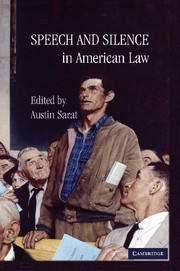Book contents
- Frontmatter
- Contents
- Contributors
- Acknowledgments
- Introduction: Situating Speech and Silence
- 1 “Our Word Is Our Bond”
- 2 Powell's Choice: The Law and Morality of Speech, Silence, and Resignation by High Government Officials
- 3 Anonymous: On Silence and the Public Sphere
- 4 Freedom of Expression, Political Fraud, and the Dilemma of Anonymity
- 5 Speech, Silence, the Body
- Index
- References
1 - “Our Word Is Our Bond”
Published online by Cambridge University Press: 04 August 2010
- Frontmatter
- Contents
- Contributors
- Acknowledgments
- Introduction: Situating Speech and Silence
- 1 “Our Word Is Our Bond”
- 2 Powell's Choice: The Law and Morality of Speech, Silence, and Resignation by High Government Officials
- 3 Anonymous: On Silence and the Public Sphere
- 4 Freedom of Expression, Political Fraud, and the Dilemma of Anonymity
- 5 Speech, Silence, the Body
- Index
- References
Summary
On January 20, 2009, Barack Hussein Obama was sworn into office as President of the United States. Or was he? A flurry of Internet activity about “oafs of office” followed the inauguration. On Wednesday, January 21, Obama again took the oath: “I do solemnly swear that I will faithfully execute the office of President of the United States, and will to the best of my ability, preserve, protect and defend the Constitution of the United States.” A January 21st White House press release briefly explained: “We believe that the oath of office was administered effectively and that the President was sworn in appropriately yesterday. But the oath appears in the Constitution itself. And out of an abundance of caution, because there was one word out of sequence, Chief Justice Roberts administered the oath a second time.”
Today, the incident appears trivial. Some claim that Obama had become President at noon anyway – even before his first oath – when George W. Bush left office. The White House's “abundance of caution” over “one word out of sequence” in an oath that it nevertheless believed “administered effectively” enough that the President had been “sworn in appropriately” does reveal, though, the importance to lawyers – and Obama is nothing if not a lawyer's lawyer – of what J. L. Austin described as the “felicity” conditions (or conditions for the success) of a performative utterance.
- Type
- Chapter
- Information
- Speech and Silence in American Law , pp. 18 - 38Publisher: Cambridge University PressPrint publication year: 2010
References
- 1
- Cited by



